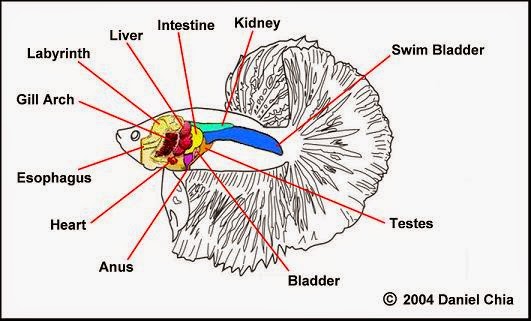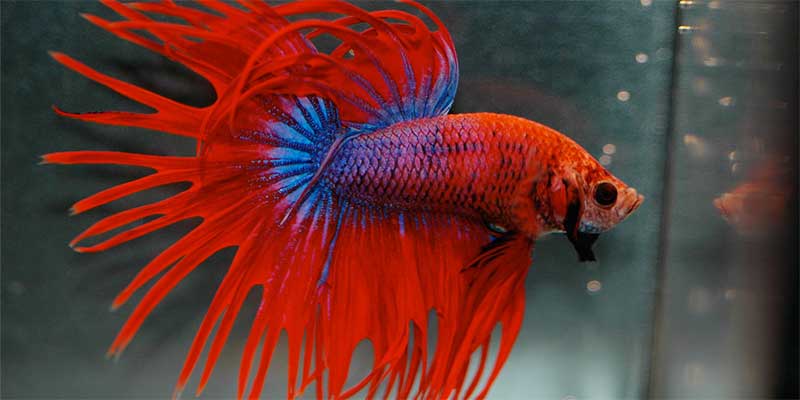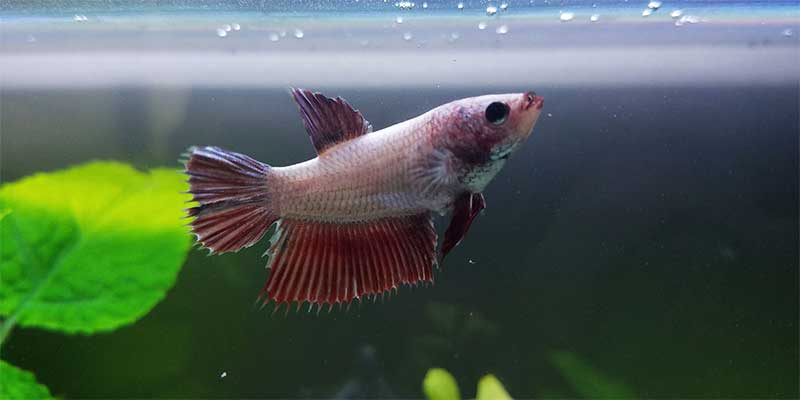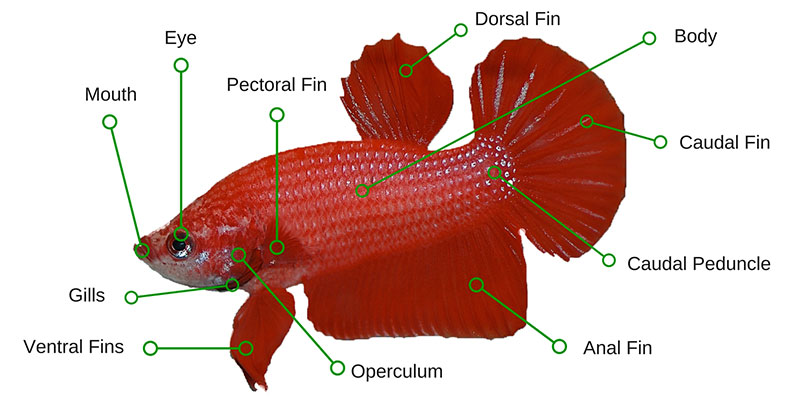Knowing your betta fish’s anatomy is part of being a good caretaker. This magnificent species has important anatomical features called out in the graphic above. Female and male betta fish have very similar makeups and are hard to tell apart when they’re young. The one pictured above is a male, but we’ll also cover some unique features of both males and females below.
External Betta Fish Anatomy
The following features make up the external anatomy of male and female betta fish. They are used for feeding, mating, fighting, swimming and more! Working from the head backward, let’s break down the key areas and explore them in greater detail.
Eyes
Betta fish have two eyes, located on each side of their head. Upon close inspection, you will notice they protrude in a bubble with the top portion making up the interorbital region and the bottom of the eye-socket being the suborbital region. A disease that affects the eye and shows visible symptoms is known as popeye. The center of their eye (iris) is a dark black color and is easily visible. The outer portion varies from fish to fish and may be any color you could think of.
Bettas have very good eyesight, as evidenced during the fighting and flaring at their owners or their own reflection. They see their surroundings in full color and do not possess eyelids or have the ability to blink like you do. Betta fish are near-sighted and their acute vision only lends its effectiveness up to 12-14 inches away. Their eyesight aids in their curious and combative nature and is why they’ll scurry up to the top when you put your finger near the water’s surface, or chase your finger as you trace it across the tank (no poking or banging).
Mouth
Did you know that in comparing the power of a betta fish’s jaws to their size (proportion) that they are stronger than the power of a great white shark? Yikes! Don’t worry about your fingers, though, they cannot harm humans. Inside their mouth, betta fish have lots of tiny and sharp teeth on their lower jaw to help break down food before ingestion. You’ll notice that their mouth is turned upwards to suck air, build bubble nests and consume prey at the water’s surface.
It’s the reason betta fish tend to look a bit smug-faced and grumpy too. Males also have a unique job during mating where they will suck the female’s eggs into their mouth from the tank’s bottom, keeping them safe and warm in a small area with mere millimeters to spare from his teeth. He will then carry them to the surface and spit them into the bubble nest where they will be suspended and fertilized. Mother nature is awesome!
Operculum
This unique part of a betta fish acts as a protective barrier or shield for the fish’s fragile gills. It also covers the ‘betta beard’ or membrane which is visible in male bettas and used as one characteristic to distinguish between sexes. When a betta is in fight mode (they are fighting fish) and trying to appear bigger and scarier, they will flare their gill covers out and extend their beard in an act of dominance.
Gills
Now that you know what protects a betta’s fragile gills, it’s important to know their function too. Like other aquatic species, their gills are used for extracting oxygen from water. Despite having a unique labyrinth organ to acquire oxygen from the water’s surface, betta fish can also get oxygen by intaking water through their mouth and passing it over their gills. In low oxygenated water environments in the wild, it is certainly beneficial to have both. You may notice that your betta sleeps submerged, likely using their gills for oxygen, or near the surface, so they can easily take breaths from the outside air.
Ventral Fin
This set of fins are used for steering and are also commonly referred to as the pelvic fins. You can see them used for turning, swimming, stopping, and to ascend and descend in the water. They are much smaller in size in females than they are in their male counterparts.
Pectoral Fin
You’re probably already familiar with the pectoral fins on a betta fish, especially if you have a dumbo or elephant ear betta. Sometimes referred to as ears, the pectoral fins are constantly in motion while a betta is navigating through the water. Pectoral fins vary in size and color depending on the age and species of a particular betta.
Dorsal Fin
Located on the top of a betta fish, the dorsal fin also varies in size and shape across different types of betta fish. Its primary job is to help stabilize the betta in water as it follows a certain trajectory. If it were missing your betta fish would struggle to travel in a straight line. In the wild, this would be particularly harmful if it prevented successful hunting of prey.
Anal Fin
Referring to the photo above, you’ll find the anal fin located just behind the ventral fins along the underside of the betta. Opposite the dorsal fin, the anal fin also stabilizes a betta fish as it navigates itself through the water.
Body
The body contains the exterior fish scales, or armor and can measure more than 2.5 inches in length. A healthy betta fish in captivity will exhibit healthy looking scales and vibrant coloring. The body is susceptible to wounds from sharp tank objects and encounters with other aggressive fish (including other bettas). If a betta is stressed, you may notice horizontal lines running down the body, especially in females. Babies or fry exhibit these horizontal lines while they are still developing and is usually no reason for concern.
Caudal Peduncle
Following the body of the betta fish, the caudal peduncle is located just before the caudal or rear fin.
Caudal Fin
Also responsible for propulsion in water is the caudal or tail fin which has many different shapes, sizes, and colors. Part of the reason betta fish are so popular as pets is because of their beautiful flowing caudal fins. In the wild a betta fish’s anatomy is much different, however, in captivity they are selectively bred to have large flowing and bright colored fins. These long fins would not be suitable in the wild because they slow a betta down and could easily become prey.
The most common tail type is the veil tail with others including halfmoon, plakat, double tail, delta tail, butterfly, rose petal, crowntail and more. The caudal fin is also vulnerable to getting nipped by other aggressive fish or even by the betta himself if he becomes bored. Pay special attention to the webbing and health of the caudal fin as it can also exhibit signs of a disease called fin rot.
Internal Betta Fish Anatomy
You might recognize a lot of the internal organs of a betta fish because you have some of the same ones. These include the liver, intestines, kidney, testes, bladder, anus, esophagus and the heart. The majority of the internal organs are located between the head and the anal fin. That’s why internal diseases cause this stomach area to swell. Each is broken down below so you can understand their function, as well as their location.

Esophagus
Connected to the mouth, the esophagus passes food, water, and air into the body and through other organs for different bodily functions.
Gill Arch
The gill arch is a bony support area where the first and second work together to pass air from the esophagus, through the gill cavity and to the labyrinth for oxygen. Gill filaments and gill rakers are attached to the gill arch.
Labyrinth
This organ is one of the coolest parts about a betta fish and it developed through evolution in stagnant low oxygen waters. Betta fish are classified as anabantoids because they are labyrinth fish. What that means is they can gulp oxygen from the air and uptake that oxygen into their bloodstream. This is different with other fish who rely solely on their gills for oxygen uptake. This is why they can survive without a bubbler or filter. Always make sure they can get to the surface of the tank’s water to use this unique ability.
Liver
A betta fish’s liver supports their digestion and storage functions within the body. Their liver secretes enzymes (bile) to process food through the stomach and then into the intestine.
Intestine
As food is broken down in the stomach, it continues through digestion and passes into the intestine. Inside the intestine is where nutrients (like protein and vitamins) are absorbed and used for fuel.
Kidney
The kidney in a betta fish acts as a filter, working to extract impurities from the bloodstream. Kidney failure is often the underlying cause of dropsy.
Swim Bladder
Located along the spine in the rear portion of the body, the swim bladder grows as a betta fish grows. It looks like an elongated balloon and helps a betta fish change its buoyancy and depth in the water. This is accomplished through regulation of air within it. You can probably see it slightly protruding on the exterior of your betta fish near the caudal peduncle.
Without this organ, they’d be floating on their side or at the surface of their aquarium. Overfeeding and an underdeveloped swim bladder can lead to swim bladder disease (SBD), exhibiting these symptoms. SBD severely impacts their survival in the wild, however, they can live a relatively healthy life in captivity.
Testes
Only present in males, the testes are the male reproductive organs.
Bladder
The urinary bladder holds the waste the kidney has filtered from the betta.
Anus
After food has been digested and the nutrients absorbed in the intestine, the remaining matter is the waste. This waste leaves the betta fish through the anus. A sign of constipation and overfeeding is stringy poop hanging from the anus.
Heart
Betta fish have a lot of heart and that’s definitely exhibited by their territorial aggression and fighting. The heart is responsible for pumping blood through their body and maintaining blood pressure.
Differences Between Males and Females
The differences between male and female betta fish will help with sexing a betta fish or determining whether a betta fish is male or female. The anatomy of a betta fish on the inside and the outside is something all caretakers should learn. These attributes will help when identifying sickness and for communicating which areas are affected. While males and females are hard to tell apart when they are fry, male betta fish become very different than females as they age. Around the 2 month mark, betta fish will begin to exhibit different sexual characteristics.
Male Betta Fish Anatomy

Males tend to have thicker bodies and also have longer fins. Their tails, anal fin, and dorsal fin make them appear much larger than females. Males will possess more vibrant external coloring on their body and fins in captivity too. Males also have a specific membrane under their gill covers (operculum) that is referred to as their beard.
You can see the beard visibly showing in the picture of the male betta above by Daniella Vereeken. When a male betta fish is in fight mode or wants to show his dominance he will flare. The male opens his gill covers and his beard is exposed, making him look larger and more threatening to others. Most beards are dark colored unless your betta fish has extremely light coloring or is white. Finally, males tend to be more aggressive than females.
Female Betta Fish Anatomy

Female betta fish are roughly the same average length as males (up to 3 inches), but their bodies are generally thinner. Possessing duller colorings than males, however, females are not without their own beauty. And just like males, females have awesome personalities
Females also have a membrane (beard) under their gill covers but it is barely visible and doesn’t normally extend past the gill covers. A final unique identifier of the female betta fish is their egg spot or ovipositor tube. This is the white dot near the base of the ventral fins (visible in the photo above). During mating, the eggs will be released from this location.
Still have questions? Ask them in the comments below.



I wanted to know age of my betta.
Can you tell me way to check it.
Check out the Lifespan page which has a graphic that may help.
why do betta fish have a hill on the bottom of their mouth
I do not see their brain on the list of internal organs. Why is that?
I only use pure drinking water. My tanks are clean. I have heaters and filters. Temp 80. Do not overfeed ( drif worms) still my fish (2 out of 7 have fin rot. Both 2 bl tanks.
Do you have a heater and filter for them? If not I’d recommend them but if so great! If they have fin rot then bettafix is amazing for that along with any other issues you may have with your bettas. Bettafix is inexpensive and it is sold in any(that I know of) store that sells fish. Bettafix actually saved one of my bettas from major fin rot, I got the poor girl in a one liter container of dirty, disgusting water. Her fins were so badly rotted that she barely had any fin left! But after bettafix treatment her fins are 100% better. I’m not saying bettafix works for all bettas but just a recommendation for you!😁
Great post! Have nice day ! 🙂 mkmky
Where is female bettas stomach and brain?